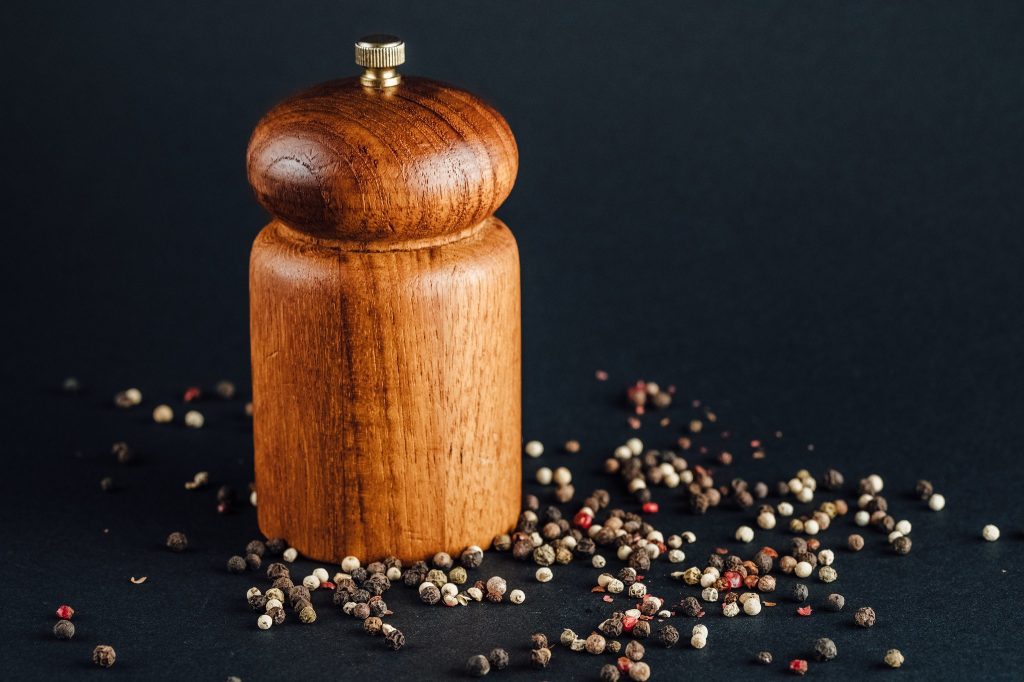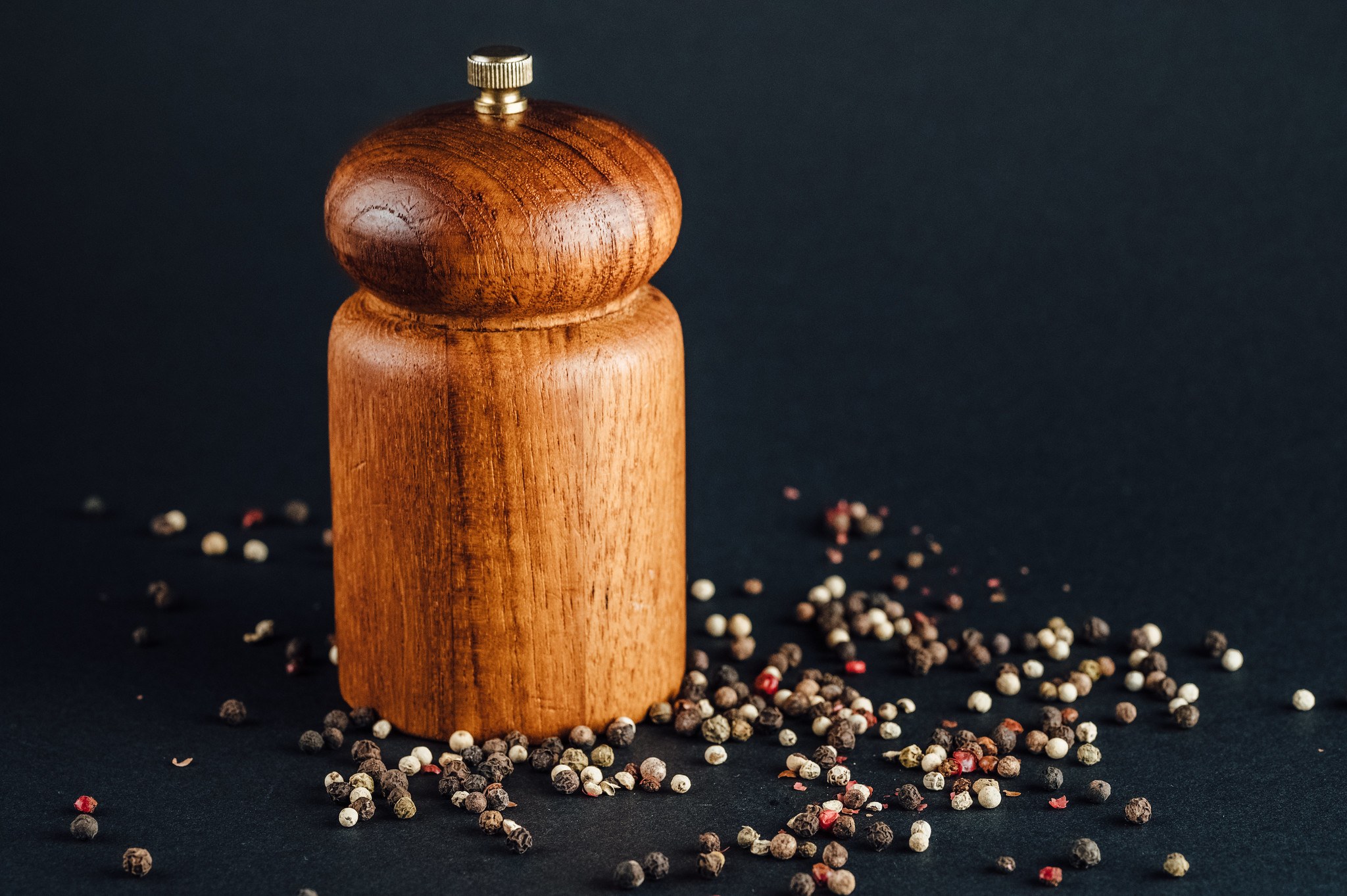Do a quick Google search for “wooden grinder” and you’re likely to find a whole lot of listings for things which are euphemistically referred to as “herb grinders”, but are actually for grinding cannabis. Apparently, freshly ground cannabis is better in some way. But grinding spices, herbs and coffee existed for centuries before the legalization of recreational cannabis.
There are good reasons for this. To start with, many spices and even coffee don’t naturally occur in the same form that we use them. What we call table salt is mined underground, where its natural appearance is as a rock. Even sea salt, which is created by evaporating sea water, naturally forms in much bigger crystals than we use. Black pepper, which is the other most common spice, is a dried berry about 5mm in diameter.
These spices, as well as pretty much all herbs, are best used fresh, or at least freshly ground. The more time they have had to sit, after grinding, the more of the flavor escapes. That’s why some restaurants might have pepper grinders, rather than just pepper shakers, to put freshly ground pepper on your salad.
Any true coffee snob can tell you that freshly ground coffee is the best, as coffee’s flavor somehow dissipates with time, so the best coffee you can get is coffee that is ground right before it is brewed. That’s why coffee shops grind the coffee as they need it and true coffee snobs will have a coffee grinder sitting on their kitchen counter, so that they can grind their coffee every morning.
Let me be clear about something here; there’s a very real difference between grinding and chopping. When something is chopped, knife-sharp blades cut through it, breaking it apart. In doing so, it doesn’t separate whatever is being chopped along the natural fault lines. When something is ground, the grinder puts pressure on it, causing pieces to chip off along the natural fault lines. Apparently, that provides more flavor, as there’s a greater surface area to come into contact with water or food.
Wood Coffee Grinder
Old-fashioned coffee grinders are often thought of as wood coffee grinders. But in reality, the only part that was wood was the case, which usually had a small drawer in it to catch the coffee coming out of the grinder. That drawer was removable, allowing the ground coffee to be dumped out into a coffee pot.
The grinder itself was made of metal and sat on top of the case. It consisted of a bowl, with the grinding “burr” located at the bottom of it. This burr was two pieces, one funnel shaped and the other cone shaped. The funnel shaped piece was permanently attached to the bowl and the cone shaped one, which fit down inside the funnel attached to the hand crank. Both parts had a rough surface, either teeth, somewhat like spiral gear teeth or a surface somewhat like a rasp. But the parts weren’t made with the same angle, so the space between them became smaller and smaller as it went down. As the hand crank was turned, the beans filtered down between the two burrs, where they were ground.
There are modern coffee grinders for sale, which are much like these, although they usually have a glass or plastic receptacle for the ground coffee, rather than the wood box. But it is also possible to buy just the mechanism for this sort of coffee grinder, as a “kit,” allowing the woodworker to make their own coffee grinder, by making the box for it.
Typically, the boxes for these coffee grinders are finger-jointed, which makes it a nice project for those who have never done finger-jointing before. The little drawer is also finger-jointed and made like any other drawer, just smaller. So this project is a great introduction to making drawers as well.
Wood Salt and Pepper Grinder
Salt and pepper grinders can be made of a variety of materials, but they are traditionally made of wood, turned on a lathe. The traditional style looks something like a chess piece, with a ball-shaped top, but without the bottom splaying out as far as a chess piece does. More modern styles can be straight sided, gently curved or even pear shaped.
Kits for making salt and pepper grinders are rather inexpensive and consist of the metal grinding disks, along with the special hardware needed to mount them into the wood body of the grinder. This leaves the actual design of the grinder totally up to the woodturner, who is only limited by their imagination.
This is actually a good project for a beginning woodturner, as it is basically spindle turning; there is no turning on the inside, like what is needed for a bowl or vase. At the same time, it introduces the idea of drilling out the inside of the turning, which is the first part of hollowing out bowls and vases. A specially sized forstner bit, which can also be used for other projects, is usually needed for this.
If both salt and pepper grinders are desired, they can be turned out of two different types of wood, one dark for pepper and the other light for salt. This makes for a very attractive presentation on the table, while making it intuitively obvious as to which is which.

Grinding Herbs
Some of us grow our own herbs at home, in our gardens. Using fresh, non-dried herbs is nice, as they have more flavor than dried ones do. But when winter comes around and the temperatures drop below freezing, those plants, like others, die. So it’s nice to have the ability to dry and grind those herbs, bottling them for later use.
Neither of the types of wood grinders above will work for grinding herbs and may or may not work well for seed type spices. The reason is that those types of grinders require a hard seed. Peppercorns and coffee beans are hard, so they work well with the types of grinders mentioned above. Some other spices, such as allspice are hard as well, so they’ll work in them too, although it will be necessary to clean out the grinder between each type of spice you’re grinding to avoid mixing flavors.
But that’s not the only option available to us. Originally, many of those herbs and spices were ground in a mortise and pestle. Those could be made of stone, or fortunately for us, wood. Once again, this is a project for the lathe, as we need to make a bowl with a rounded bottom for the mortise and turn something like a miniature baseball bat for the pestle.
It’s important to use a dense, tight grained wood for this. Open-grained woods allow opportunities for tiny bits of the herbs to get caught in the grain, affecting the flavor of anything ground afterwards. While some oiling of the wood is a good idea to protect the wood, that oil needs to dry fully before the mortar and pestle are used; otherwise, it will cause the dried, ground herbs to stick.
For those who don’t have a lathe, those herbs can also be ground in an electric spice grinder. I have one of those as well and it’s kind of like a miniature food processor. It works well, chopping the herbs very fine, but there’s nothing wood or even old-fashioned about it.
As for those other “pocket herb grinders” that are out there, we’ll leave those for someone else to talk about.




